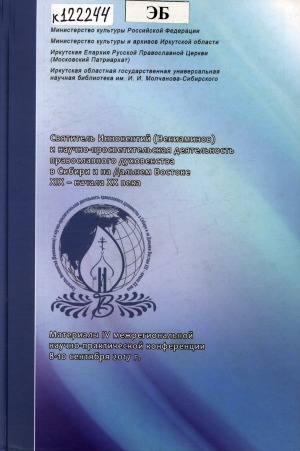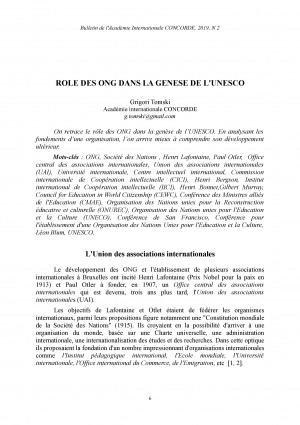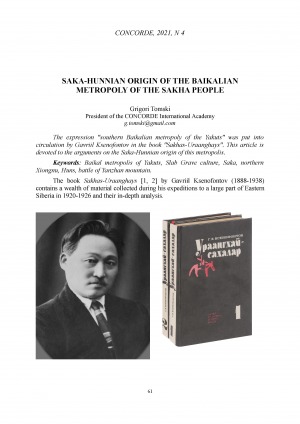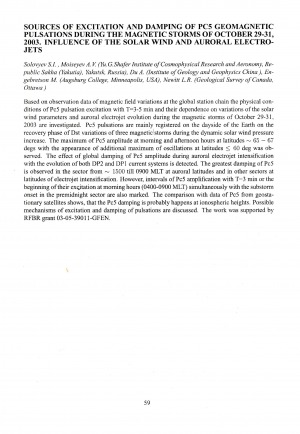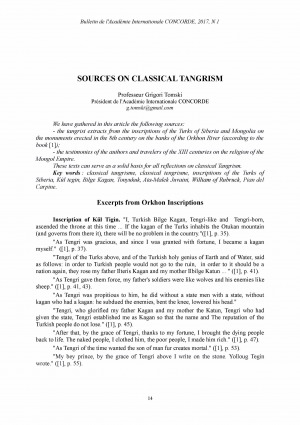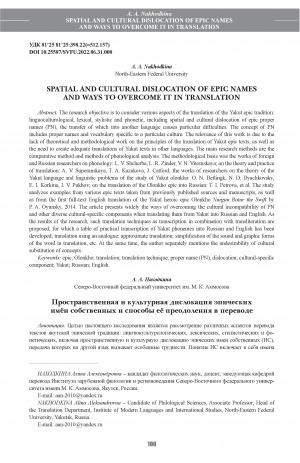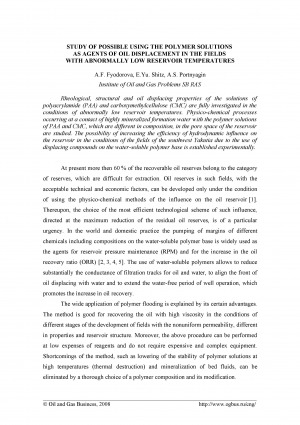Источник: SHS Web of Conferences. - 2022, Т. 134.
Количество страниц: 7 с.
Целью данного исследования является изучение звукоиздающих подвесок на шаманском костюме эвенков, якутов и нганасан в единстве шаманского ритуального комплекса и ритуальных музыкальных традиций. Шаманские подвески интерпретируются как особый текст культуры, отражение геокультурных представлений народов Арктики. Статья основана на материалах полевых исследований, проведённых авторами на Таймыре в 1989–1990 годах, в Оленёкском эвенкийском национальном округе Якутии в 2014 году, а также на научных публикациях. Звуковой мир шаманского ритуала — это сложная звуковая картина, которая формируется при использовании вокальных, вербальных, вокально-речевых, сигнальных, инструментальных типов интонации. Движения шамана сопровождаются звуком сталкивающихся подвесок на костюме шамана и его составляющих (повязке, обуви, перчатках).
Звукоиздающие подвески были описаны этнографами и музыковедами, но не рассматривались в связи с геокультурными исследованиями. Металлические подвески на костюме шамана обозначают священные пространственные модели Вселенной (образы небесных тел — солнца, луны, звёзд), мифологические пространства Верхнего, Среднего и Нижнего миров, населённые духами-помощниками шамана — птицами, животными, антропоморфными существами, символизируют части человеческого тела и т. д. Перспективы изучения подвесок на костюме шамана как символического воплощения ландшафта заключаются в более полном описании и обобщении всех известных материалов, включая анализ костюмов шаманов из этнографических музейных коллекций.
Reflection of Arctic geocultures in the sounding attributes of the shaman costumes of Sakha, Evenks and Nganasans / Oksana Dobzanskaya, Vera Nikiforova, Varvara Dyakonova ; Arctic State Institute of Culture and Arts // SHS Web of Conferences. - 2022, Т. 134. - С. 1-7
Количество страниц: 220 с.
- Религия. Теология,
- Краеведение. Археология. География. Биографии. История > Историческая наука. Историография > Всеобщая история. История отдельных стран и народов,
- НАУКА ЯКУТИИ > РЕЛИГИЯ. ТЕОЛОГИЯ,
- НАУКА ЯКУТИИ > КРАЕВЕДЕНИЕ. ГЕОГРАФИЯ. БИОГРАФИИ. ИСТОРИЯ > Историческая наука. Историография > Всеобщая история.
Есть много литературных произведений об Аттиле и Чингисхане, написанных европейцами, американскими и российскими авторами. Один из их главных недостатков - вопиющее незнание религии этих великих исторических личностей. Мои работы про Аттилу, посвящены разбору великих исторических загадок: - Отношения Аттилы и Аэция; - Загадки каталаунских полей; - Тайны встречи Аттилы и Папы Льва в Италии. Форма литературных произведений позволяет не только логически анализировать исторические события, а также создать психологические портреты участников этих событий для лучшего понимания глубинной мотивации их действий.
Tomski, G. V. Religion of Attila / Grigori Tomski // Bulletin de l’Académie Internationale CONCORDE. - 2017. – N 2. – С. 3-52.
Количество страниц: 12 с.
Tomski, G. V. Role des ong dans la genese de l'UNESCO / Grigori Tomski // Bulletin de l’Académie Internationale CONCORDE. - 2019. – N 2. – С. 6-16.
Количество страниц: 14 с.
- Общественные науки. Образование > Этнография. Обычаи. Жизнь народа. Нравы,
- Краеведение. Археология. География. Биографии. История > Историческая наука. Историография > Всеобщая история. История отдельных стран и народов,
- НАУКА ЯКУТИИ > КРАЕВЕДЕНИЕ. ГЕОГРАФИЯ. БИОГРАФИИ. ИСТОРИЯ > Историческая наука. Историография > Всеобщая история,
- НАУКА ЯКУТИИ > ОБЩЕСТВЕННЫЕ НАУКИ > Этнография. Обычаи. Жизнь народа. Нравы.
Tomski, G. V. Saka-hunnian origin of the baikalian metropoly of the sakha people / Tomski Grigori ; Académie internationale CONCORDE // Concorde. – 2021. – N 4. – С. 61-74.
Количество страниц: 13 с.
- Религия. Теология,
- Общественные науки. Образование > Этнография. Обычаи. Жизнь народа. Нравы,
- Искусство. Фотография. Музыка. Игры. Спорт > Музыка,
- НАУКА ЯКУТИИ > РЕЛИГИЯ. ТЕОЛОГИЯ,
- НАУКА ЯКУТИИ > ОБЩЕСТВЕННЫЕ НАУКИ > Этнография. Обычаи. Жизнь народа. Нравы,
- НАУКА ЯКУТИИ > ИСКУССТВО. ФОТОГРАФИЯ. МУЗЫКА. ИГРЫ. СПОРТ > Музыка.
Dobzhanskaya, O. E. Samoyedic shamanic drums: some symbolic interpretations / Oksana Dobzanskaya // Shamanhood and Mythology Archaic Techniques of Ecstasy and Current Techniques of Research : Honour of Mihály Hoppál, celebrating his 75th Birthday / edited by Attila Mátéffy, György Szabados, Tamás Csernyei. - Budapest : Robinco, 2017. - 512 p. - P. 63-75.
Количество страниц: 1 с.
Sources of excitation and damping of PC5 geomagnetic pulsations during the magnetic storms of october 29-31, 2003 influence of the solar wind and auroral electrojets : [тезисы докладов] / Solovyev S. I., Moiseyev A. V., Du A., Engebretson M., Newitt L. R. // International symposium on Solar Extreme Events of 2003 : programme and abstract book. – Москва : УНЦ ДО, 2004. – P. 59.
Количество страниц: 12 с.
В этой статье мы собрали следующие источники: - тангристские отрывки из надписей тюрков Сибири и Монголии на памятниках, воздвигнутые в VIII веке на берегу реки Орхон ; - свидетельства авторов и путешественников XIII века о религии Монгольской империи. Эти тексты могут служить прочной основой для всех размышлений о классическом тангризме.
Tomski, G. V. Sources on classical Tangrism / Grigori Tomski // Bulletin de l’Académie Internationale CONCORDE. - 2017. – N 1. – С. 14-24.
Количество страниц: 13 с.
Nakhodkina, A. A. Spatial and cultural dislocation of epic names and ways to overcome it in translation / A. A. Nakhodkina // Вестник Северо-Восточного федерального университета им. М. К. Аммосова. Серия "Эпосоведение" - 2022, N 3 (27). - С. 86-99.
DOI: 10.25587/SVFU.2022.86.31.008
Количество страниц: 14 с.
- Языкознание. Филология. Художественная литература > Литература. Литературоведение > Теория литературы. Изучение литературы. Литературная техника > Художественная литература на отдельных языках > Якутская (саха) литература,
- НАУКА ЯКУТИИ > ЯЗЫКОЗНАНИЕ. ФИЛОЛОГИЯ. ЛИТЕРАТУРОВЕДЕНИЕ. ХУДОЖЕСТВЕННАЯ ЛИТЕРАТУРА > Литература. Литературоведение.
Khusaynova, G. R. Specifics of the dastan genre structure in variants of “Tahir and Zukhra” and “Leyla and Majnun”: Creative techniques and their forms in Tatar romanic dastans / G. R. Khusaynova ; Северо-Восточный федеральный университет им. М. К. Аммосова // Вестник Северо-Восточного федерального университета им. М. К. Аммосова. Серия "Вопросы национальных литератур". - 2023. - N 1 (9). - С. 42-55.
DOI: 10.25587/litteraesvfu.2023.11.77.006
Количество страниц: 12 с.
- Прикладные науки. Медицина. Ветеринария. Техника. Сельское хозяйство > Инженерное дело. Техника в целом > Горное дело. Горные предприятия (рудники, шахты, карьеры),
- НАУКА ЯКУТИИ > ПРИКЛАДНЫЕ НАУКИ. МЕДИЦИНА. ТЕХНИКА. СЕЛЬСКОЕ ХОЗЯЙСТВО > Инженерное дело. Техника в целом > Горное дело. Горные предприятия (рудники, шахты, карьеры).
Fyodorova, A. F. Study of possible using the polymer solutions as agents of oil displacement in the fields with abnormally low reservoir temperatures / A. F. Fyodorova, E. Yu. Shitz, A. S. Portnyagin // Нефтегазовое дело. - 2008, N 1. - С. 18.

